Den Bahnhof lesen, wenn man mit einer Behinderung lebt
Gedränge, Bauarbeiten, verspätete Züge, Lautsprecherdurchsagen: Für Menschen mit Behinderung kann die Orientierung in Bahnhöfen bisweilen zu einer echten Herausforderung werden. Dies zeigt eine Studie der Universität Freiburg, die während einer Grossbaustelle im Bahnhof Freiburg durchgeführt wurde.
Bahnhöfe sind Orte mit einer Fülle an wichtigen Informationen: eine dichte Beschilderung, Zugfahrpläne auf Plakaten und Bildschirmen, Braille-Tafeln, Lautsprecherdurchsagen usw. Angesichts dieses Informationsüberflusses fällt es den Nutzer_innen von öffentlichen Verkehrsmitteln mitunter schwer, sich zurechtzufinden, insbesondere bei unvorhergesehenen Ereignissen, Verspätungen oder Bauarbeiten. Für Menschen mit Behinderung ist diese Aufgabe oft noch anspruchsvoller, da das Wahrnehmen und Interpretieren der Informationen je nach Fähigkeiten oder Bedürfnissen besonders komplex sein kann.
Sich der Realität stellen
Ausgestattet mit einem Smartphone oder Tablet haben Menschen mit motorischen, sensorischen (Seh- und Hör-) sowie kognitiven Einschränkungen von Januar bis April 2025 den Bahnhof Freiburg durchstreift und sämtliche Informationen dokumentiert, die sie lesen, hören oder fühlen mussten, um sich orientieren zu können.
«Auf diese Weise konnten wir nachvollziehen, welche Strategien diese Personen anwenden mussten, um sich in einer Umgebung zurechtzufinden, die sich mitten im Umbau und in einem tiefgreifenden Wandel befand», erklärt Philippe Humbert, Projektleiter am Institut für Mehrsprachigkeit der Universität Freiburg.
Lesen, um Hindernisse zu überwinden
- Technologische und digitale Hilfsmittel: Während einige Teilnehmende die Anwendungen auf ihrem Smartphone (insbesondere dank Geolokalisierungs-Tools) erfolgreich nutzen konnten, erwiesen sich diese für andere als kaum überwindbare Hürde. Um beispielsweise ohne Bankkarte die Toiletten des Bahnhofs zu betreten, mussten Anweisungen gelesen werden, die für manche sehbehinderte oder kognitiv beeinträchtigte Menschen nicht selbstständig umsetzbar waren.
- Vielzahl von Hilfsmitteln: Um den richtigen Weg zu finden, müssen oft mehrere Hilfsmittel konsultiert und teils komplexe Verknüpfungen zwischen den Informationsquellen hergestellt werden. So hatten beispielsweise die meisten Teilnehmenden Mühe, von den SBB-Bahnsteigen zu den Busperrons der TPF zu gelangen.
- Verwirrende Beschilderung: Einige unter Zeitdruck verfasste Hinweise – etwa zu defekten Fahrstühlen – ermöglichten es den Teilnehmenden nicht, den alternativen Weg autonom zu finden. In solchen Situationen kann die Hilfe durch Bahnhofspersonal ausreichen, dieses stand jedoch nicht immer zur Verfügung.
- (Un)vorhersehbare Hindernisse: Die SBB bemühen sich, gewisse Hindernisse durch eine angepasste Beschilderung zu antizipieren, etwa mit Schildern, die Umwege für Menschen mit eingeschränkter Mobilität ausweisen. Jedoch unabhängig davon, ob gerade Bauarbeiten stattfanden oder nicht, blieben mehrere Bereiche des Bahnhofs mit Hindernissen übersät – etwa ein Schild, das mitten auf dem Gehweg stand und den Durchgang unpassierbar machte.
- Ein inklusiver Ansatz über die Thematik von Behinderung hinaus: Die Beobachtungen von Menschen mit Behinderung machten es möglich, Herausforderungen beim Lesen von Informationen zu identifizieren, die alle Nutzer_innen des Bahnhofs betreffen können – mit oder ohne Behinderung.
Originelle Ideen zur Verbesserung der Informationsvermittlung
Auf Grundlage dieser Beobachtungen sowie der Diskussionen mit den Teilnehmenden hat Philippe Humbert, Autor der Studie, mehrere Handlungsansätze formuliert, die weiter untersucht werden sollen. Seiner Ansicht nach ist es unerlässlich, «Synergien zwischen akademischen, zivilgesellschaftlichen, institutionellen und pädagogischen Akteur_innen sowie den Bereichen Bauwesen und öffentlicher Verkehr zu schaffen».
Diese innovativen Ansätze reichen von der Entwicklung von Schulungen zum Auffinden und Interpretieren von Informationen im Bahnhof, mit oder ohne Smartphone-App, bis hin zur Anstellung von Menschen mit Behinderung in Kommunikationsfunktionen bei öffentlichen Verkehrsbetrieben. Sämtliche Ansätze und Analysen sind im Bericht enthalten, der in einer Lang-, Kurzversion sowie in Leichter Sprache verfügbar ist.
Zur Studie
Projektwebseite
Detaillierter Forschungsbericht (auf französisch)
Zusammenfassung des Forschungsberichts (auf französisch)
Kurzversion in Leichter Sprache

Podcast "Adieu, merci, Suisse" - Episode «Traduire, c’est trahir» – le plurilinguisme entre choc culturel, créativité et gymnastique mentale
Notre cheffe de projet Simone Morehed a discuté avec Swissinfo dans le cadre de leur troisième épisode du nouveau podcast «Adieu, merci la Suisse» sur la gymnastique mentale et jeux linguistiques, comment l'age influence l'apprentissage et les bénéfices cognitifs.
Vous pouvez écouter le podcast ici.
Image: Simone Morehed discute avec les journalistes et présentatrices du podcast Emilie Ridard (au centre) et Camille Kündig (à droite). © Swissinfo
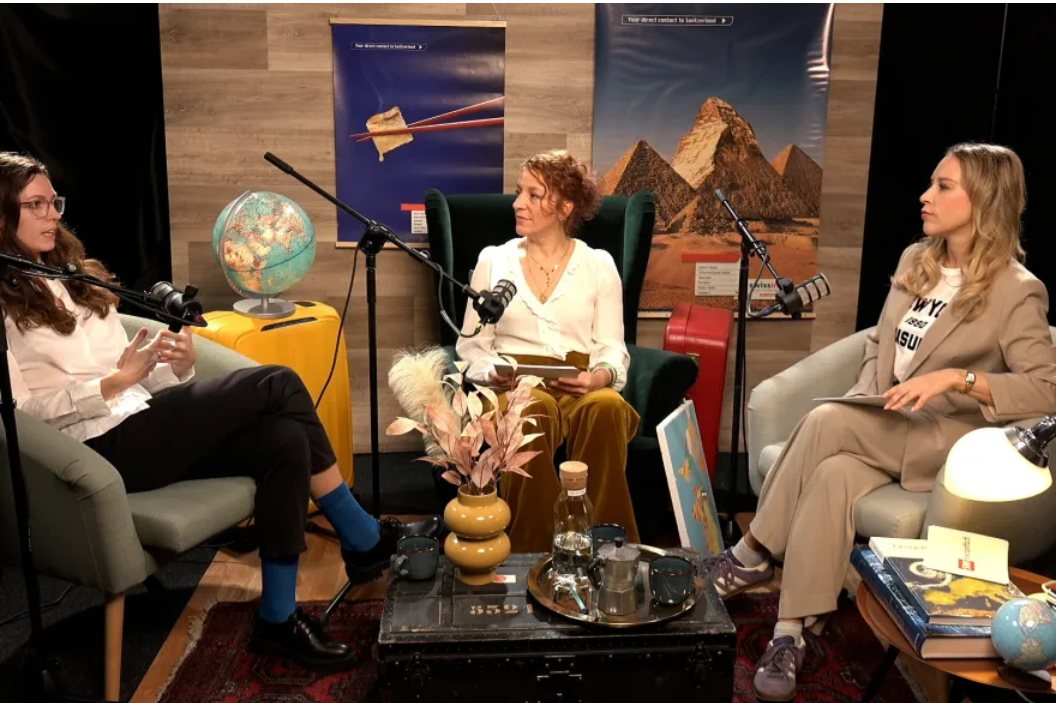
Podcast «Ade merci, Schweiz»: Von der Fremdsprache zur zweiten Muttersprache – das sind die Tricks
Unsere Forscherin Giulia Berchio hat mit Swissinfo für die dritte Episode ihrer Podcastserie "Ade merci, Schweiz" über Sprachenlernen als mentale Gymnastik und den Vorteil von Fernsehserien, um das Hörverständnis zu verbessern.
Hören Sie die Podcastfolge hier.
Bild: Giulia Berchio im Gespräch mit den Journalistinnen Claire Micallef (mitte) und Camille Kündig (rechts). © Swissinfo

Apprentissage des langues à l'ère de l'IA - Entretien avec Isabelle Udry dans La Liberté
Un entretien dans La Liberté entitulé DeepL, ChatGPT, Duolingo… L’IA va-t-elle remplacer les profs de langues? Pour la Fribourgeoise Isabelle Udry, «rien ne remplace l’accompagnement humain»
Une interview intéressante de notre cheffe de projet Isabelle Udry dans le journal La Liberté sur l'utilisation des technologies d'IA dans l'enseignement des langues. Selon elle, les outils d'IA et les applications d'apprentissage des langues peuvent être utilisés à bon escient dans l'enseignement des langues, mais rien ne remplace l'accompagnement humain. L'apprentissage des langues ne se résume pas à un simple apprentissage par cœur de vocabulaire ou à une traduction instantanée : l'interaction humaine, le soutien et la motivation sont essentiels.
👉Lisez l'article complet par Sophie Gremaud dans La Liberté : https://lnkd.in/eeuriYEe
Podcast CeDiLE: Rätoromanisch in der Deutschschweiz: Von Inseln und Übergängen
In der ersten Ringveranstaltung tauschen sich zwei Rätoroman:innen aus der Diaspora rumantscha aus – und zwar auf Deutsch. Die Schriftstellerin Viola Cadruvi engagiert sich vielseitig für das Rätoromanische, und die Soziolinguistin Claudia Cathomas erforscht die Sprachpraktiken rätoromanischer Familien in der Deutschschweiz. In einem gutgelaunten und offenen Gespräch geben sie ein differenziertes Bild der Situation von Familien in der Diaspora rumantscha wieder und besprechen die Herausforderungen, die entstehen, wenn eine Minderheitssprache an die nächste Generation weitergegeben werden soll.
Mehr dazu: Rätoromanisch in der Deutschschweiz: Von Inseln und Übergängen [Podcast] – CeDiLE
Interview CeDiLE: Wenn klatschen hilft, Deutsch schreiben zu lernen: Ein phonologischer Ansatz zur Alphabetisierung von Erwachsenen
Ein Interview des CeDiLE mit Marie-Anne Morand, Projektleiterin am Wissenschaftlichen Kompetenzzentrum für Mehrsprachigkeit
Warum ist es für DaZ-Lernende vorteilhafter, die kyrillische als die arabische Schrift zu können? Wie denken wir über Schrift? Wie denken Menschen, die ihre Sprache nicht mit Alphabeten festhalten, über Schrift? Wie kann man im Unterricht und ohne gemeinsame Sprache aufzeigen, wie wir die gesprochene Sprache verstehen und festhalten?
Marie-Anne Morand forscht zum Schreibenlernen in Alphabetisierungskursen für migrationsbedingt mehrsprachige Personen. Im folgenden Interview erzählt sie uns, was sie zu diesen Fragen im Rahmen ihrer Forschungsprojekte Alpha I und II erfahren hat. Dabei zeigt sie, welche Unterrichtsmethoden und welches Unterrichtsmaterial sie entwickelt hat und nun für Lehrpersonen aufbereitet.
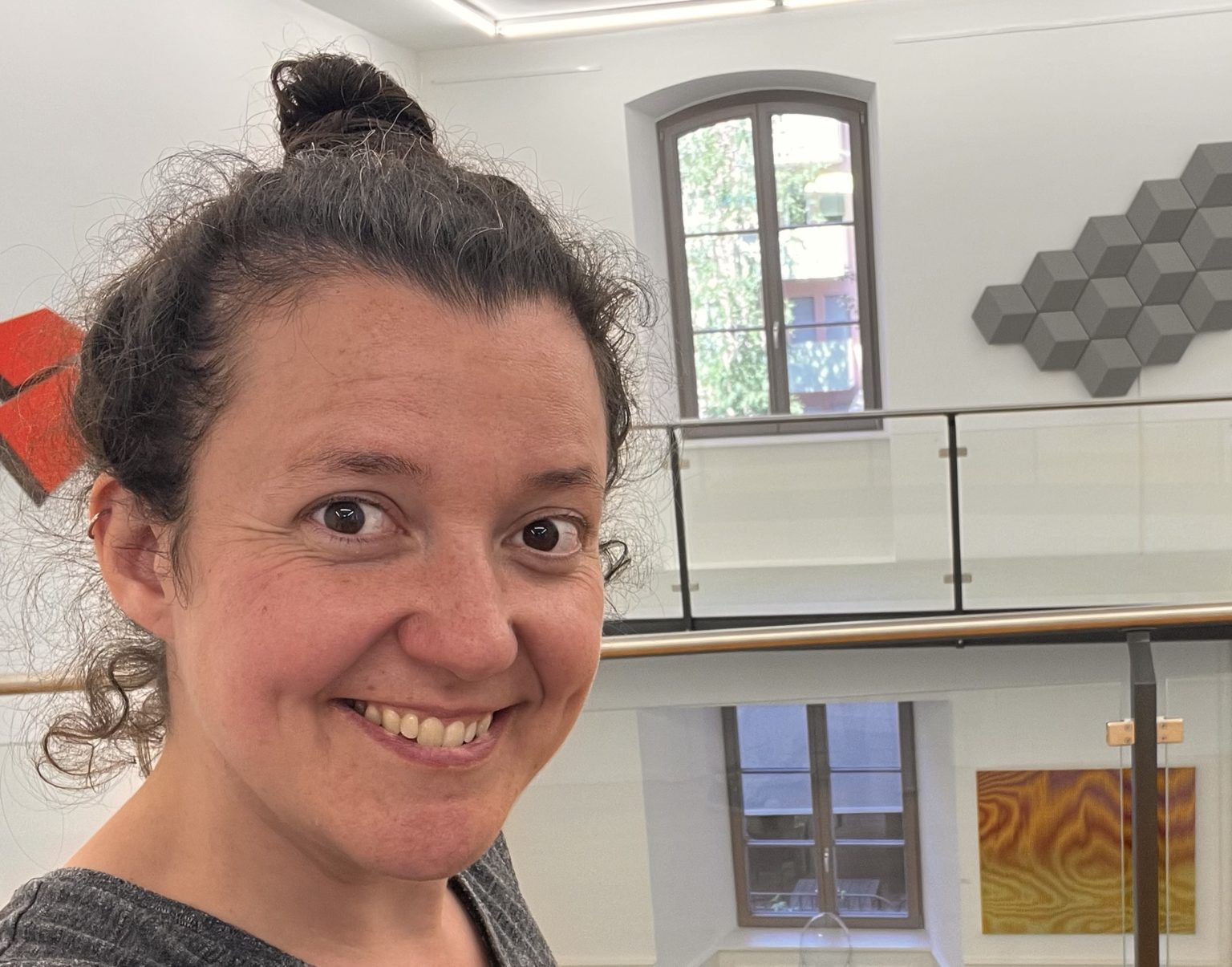
Positionspapier „Frühfranzösisch-debatten: Politik, Wissenschaft und Schule“
Die Diskussion um das Frühfranzösisch in der deutschsprachigen Schweiz beschäftigt Politik, Schulen und Forschung seit Jahrzehnten – oft mit denselben Argumenten. In seinem Positionspapier analysiert das Institut für Mehrsprachigkeit die aktuelle Debatte und plädiert für mehr Differenzierung.
Das Papier zeigt auf, dass in der öffentlichen Diskussion unterschiedliche Ebenen – politische, sprachideologische, pädagogische und institutionelle – häufig vermischt werden. Eine sachliche und zielführende Debatte ist jedoch nur möglich, wenn diese Aspekte klar voneinander getrennt und unabhängig diskutiert werden.
Der Beitrag verstehts sich als Versuch, zu klären, auf welche Teilfragen der Debatte die Wissenschaft Antworten suchen soll und kann und welche Probleme und Entscheidungen politischer Natur sind. Diese Klärung sollte dazu beitragen, die Debatte zu versachlichen.
Dringlichkeit übersetzen: Mehrsprachigkeit im Härtetest der Pandemie
In der Schweiz ist die Kommunikation mit der Bevölkerung in Krisenzeiten eine grosse Herausforderung. Wie kann sichergestellt werden, dass alle Einwohner_innen – unabhängig von ihrer Sprache oder ihren Sprachkenntnissen – die wichtigsten Informationen erhalten? Für die Behörden und die Zivilgesellschaft stellte die COVID-19-Pandemie einen echten Stresstest dar. Das Wissenschaftliche Kompetenzzentrum für Mehrsprachigkeit der Universität Freiburg hat dazu eine umfassende Studie durchgeführt und macht die wichtigsten Ergebnisse in Form eines interaktiven Posters öffentlich zugänglich.
Auch wenn die COVID-19-Krise inzwischen weit zurückzuliegen scheint, hat sie sich tief ins kollektive Gedächtnis eingeschrieben. In der Schweiz änderten sich die Regeln beinahe wöchentlich – oft auch von Kanton zu Kanton. Wie viele Personen durften sich treffen? Durfte man sich ohne Maske auf eine Restaurantterrasse setzen? Wer konnte ein COVID-Darlehen beantragen, und unter welchen Bedingungen?
Neben diesem anfänglichen Informationswirrwarr mussten die Behörden sicherstellen, dass ihre Botschaften nicht nur alle Bewohner_innen erreichten, sondern auch so verständlich wie möglich waren. Das Forschungsprojekt «Mehrsprachigkeit in einer Gesundheitskrisensituation» zieht Bilanz über die beispiellosen Kommunikationsbemühungen von Behörden und zivilgesellschaftlichen Akteur_innen.
Auf den Spuren von Information und Übersetzung
Auf Basis einer Erhebung der während des ersten Pandemiejahres (2020/2021) publizierten Informationen sowie von Interviews mit insgesamt 90 Personen, die Übersetzungsleistungen erbracht haben, stellten die Autor_innen fest:
- Informationsflut: Bundes-, Kantons- und Gemeindebehörden sowie Organisationen der Zivilgesellschaft verbreiteten eine enorme Menge an Informationen – über analoge und digitale Kanäle, in schriftlicher und audiovisueller Form. Angesichts dieser Fülle hatten die Empfänger_innen teilweise Mühe, den Überblick zu behalten.
- Ein beachtlicher Übersetzungsaufwand, der dennoch viele nicht erreichte: Die Bundesbehörden, insbesondere das Bundesamt für Gesundheit, übersetzten Texte in nicht weniger als 26 Sprachen, darunter auch in Leichte Sprache und Gebärdensprache. Trotz dieses Engagements konnten gewisse soziale Gruppen aufgrund der Verbreitungswege nicht erreicht werden.
- Ungleichgewicht bei den übersetzten Inhalten: Informationen zu Präventions- und Hygieneregeln wurden deutlich häufiger übersetzt als Inhalte und Formulare zu finanziellen Unterstützungsleistungen.
- Einsatz von Freiwilligen: Des Weiteren kamen freiwillige, nicht-professionelle Übersetzer_innen zum Einsatz. Meist handelte es sich um Personen mit Migrationshintergrund sowie um zivilgesellschaftliche Organisationen, die im Hintergrund dafür sorgten, dass Informationen zugänglich wurden.
Gerüstet für die nächste Krise?
Um diese Erkenntnisse zu dokumentieren, hat das Wissenschaftliche Kompetenzzentrum für Mehrsprachigkeit der Universität Freiburg ein interaktives Poster entwickelt, das die Mechanismen und Herausforderungen einer mehrsprachigen Krisenkommunikation sichtbar macht. Unter dem Titel «Tracing Translation» lädt dieses neue Instrument alle Interessierten, Forschende, Fachpersonen aus den Bereichen Gesundheit, Soziales und Bildung sowie Studierende dazu ein, die wichtigsten Ergebnisse der Studie visuell und dynamisch zu erkunden.
Das Poster ist online auf Deutsch, Französisch, Italienisch und Englisch zugänglich und wird im Rahmen von Explora – dem «Festival für Kultur, Wissenschaft & Gesellschaft» bzw. Tag der offenen Tür der Universität Freiburg – am 20. September 2025 vorgestellt.

Retour sur la journée d’étude Langues et histoire
Le 26 août, l’Institut de plurilinguisme a accueilli la journée d’étude Langues et histoire : un dialogue interdisciplinaire, consacrée aux liens entre langues, pratiques et politiques linguistiques, et dynamiques historiques. L’événement a réuni une vingtaine de participant·e·s issu·e·s de diverses institutions suisses et européennes.
Les six interventions ont permis de croiser des approches issues de la sociolinguistique, de l’histoire sociale, de l’anthropologie et de la didactique des langues, afin d’interroger la manière dont le passé éclaire notre compréhension des dynamiques langagières contemporaines. Les chercheur·e·s ont proposé une lecture tripartite du fait linguistique historique - formes, usages, discours/idéologies - qui dépasse les dichotomies classiques et permet de mieux comprendre comment les langues s’inscrivent dans des dynamiques de pouvoir, de subjectivation et de transmission.
La journée d’étude a approfondi la réflexion sur une « ethnographie du passé », une posture qui explore les dimensions linguistiques et sémiotiques des phénomènes sociaux à partir de textes, témoignages et traces. Elle envisage le passé comme une réalité complexe, fragmentaire et indirecte, accessible par l’analyse croisée des indices historiques.
Enfin, les échanges ont ouvert un dialogue réflexif sur les finalités de l’histoire dans l’étude des langues : comment travaille-t-on le passé, pour raconter quelle histoire, et à qui ? Cette interrogation invite à repenser les politiques de lecture et d’écriture, ainsi que la fonction critique de l’histoire dans nos disciplines. Les chercheur·e·s proposent une voie intermédiaire qui dépasse la tendance à abstraire le passé et celle à sacraliser les documents comme vérités absolues : le passé est envisagé comme une ressource vivante, constamment mobilisée, réinterprétée, voire constestée dans le présent.
La réflexion se poursuivra à travers un panel au congrès du Réseau francophone de sociolinguistique 2026 à Paris, la publication d’un numéro spécial, et un entretien publié sur la plateforme du CeDiLE.
Cette journée d’étude a bénéficié du soutien de l’Institut de plurilinguisme, du Fonds national suisse, du Fonds de recherche du centenaire de l’Université de Fribourg, ainsi que de Chocolat Villars et de Fribourg Tourisme.
Photo (de gauche à droite) : Narcís Iglésias (Universitat de Girona), Maria Rosa Garrido Sardà (Universitat Autònoma de Barcelona), Alice Burrows (Université Sorbonne Nouvelle), Kevin Petit (Université Clermont Auvergne), Émeline Beckmann (Université de Fribourg), Zorana Sokolovska (Université de Fribourg), James Costa (Université Sorbonne Nouvelle). © Anne-Laurence Jaunin
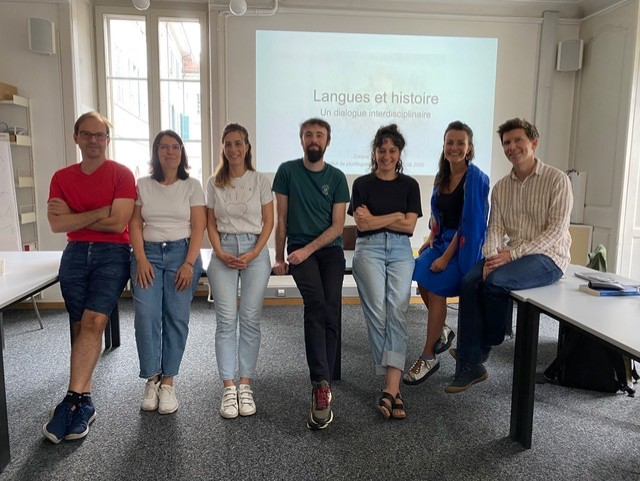
Une année de transitions et de perspectives : le Rapport annuel 2024 de l’Institut de plurilinguisme
2024 a été une année charnière pour l’Institut de plurilinguisme, marquée par des changements importants - la clôture d’un cycle de recherche et la mise en place de nouvelles orientations pour l’avenir. Dans son éditorial, la directrice de l’Institut revient sur les nombreux défis, réussites et moments marquants qui ont rythmé cette année de transition.
Parmi les faits saillants de 2024 figure la conclusion du programme de recherche 2021–2024 du Centre scientifique de compétence sur le plurilinguisme (CSP), dont les résultats ont été présentés lors d'une conférence en novembre, réunissant une septantaine de participant·e·s autour de thématiques essentielles telles que la digitalisation en classe de langue ou encore l’enseignement précoce.
L’année a également été consacrée à l’élaboration du nouveau programme de recherche 2025–2028, fruit d’une large consultation menée avec l’Office fédéral de la culture. Douze projets ont été retenus, reflétant la richesse des propositions soumises et la diversité des enjeux en matière de plurilinguisme.
Le rapport annuel revient aussi sur plusieurs transitions internes importantes : le départ à la retraite de la cheffe de projet Renata Coray, l’arrivée de nouveaux profils scientifiques, la poursuite de doctorats brillamment défendus, et la recherche d’une nouvelle directrice administrative dû à la retraite de Susanne Obermayer.
Enfin, l’année a été marquée par deux événements majeurs en didactique des langues étrangères, renforçant le rôle de l’Institut comme lieu de dialogue entre recherche et pratique
- Le colloque annuel de l’association INNLAC (International Network of National Language Centres) qui a rassemblé des personnes représentant différents pays du réseau sur la thématique du parcours de professionnalisation des enseignant·e·s de langues, et
- le colloque oganisé par le CeDiLE (Centre de Didactique des langues étrangères) sur « De la recherche empirique à la pratique en classe de langue étrangère et vice-versa ».
Découvrez le Rapport annuel 2024 dans son intégralité ici.
Nous remercions chaleureusement toutes les personnes et institutions partenaires qui rendent ces avancées possibles et surtout toutes et tous les collaborateur-ice-s de l’Institut de plurilinguisme pour leur professionnalisme et engagement.
Synthese zum Forschungsbericht "Die Diaspora rumantscha in der Deutschschweiz – Eine Situations- und Bedarfsanalyse – Fokus Familien"
Wie lebt und überlebt Rätoromanisch ausserhalb Graubündens? Dieser Frage geht der Forschungsbericht „Die Diaspora rumantscha in der Deutschschweiz: Eine Situations- und Bedarfsanalyse – Fokus Familien“ nach. Jetzt ist auch eine Zusammenfassung des Berichts in fünf verschieden Sprachen, inklusive Rätoromanisch verfügbar. Die Studie von Claudia Cathomas, Flurina Graf und Cordula Seger untersucht die Situation rätoromanischer Familien in drei Deutschschweizer Städten. Ziel war es, herauszufinden, wie es um Bildungs-, Betreuungs- und Freizeitangebote in Rätoromanisch bestellt ist, welche Bedürfnisse Familien haben, um die Sprache weiterzugeben, und welche konkreten Massnahmen die Sprachförderung in der Diaspora unterstützen können.
Hohes Engagement – wenig Struktur
Die Studienautorinnen zeichnen ein ambivalentes Bild: Zwar ist die Motivation vieler Eltern, Rätoromanisch weiterzugeben, gross – die sprachliche Realität im Alltag aber oft herausfordernd. In der ausserkantonalen Diaspora ist Rätoromanisch ausserhalb der Familie kaum präsent. Eltern fehlt die sprachliche Praxis, was mit der Zeit zu Unsicherheit oder einem schleichenden Verlust des Wortschatzes führen kann.
Den Kindern wiederum fehlen der sprachliche Kontext sowie das Bewusstsein, dass Rätoromanisch nicht nur eine Familiensprache ist, sondern eine lebendige Sprache mit öffentlicher Relevanz, die auch in anderen Lebensbereichen verwendet wird.
Sprache braucht Raum – und Input
Ein zentrales Ergebnis der Studie: Je mehr rätoromanischer Input ein Kind erhält, desto grösser sind seine Sprachkompetenzen – unabhängig davon, ob beide Elternteile perfekt sprechen oder ob ein Elternteil Rätoromanisch erst später gelernt hat. Nicht Korrektheit steht im Vordergrund, sondern Quantität und Alltagstauglichkeit. Interessant ist auch die Rolle der Kinder selbst: Wie sie die Zweisprachigkeit erleben, kann entscheidend sein für die familiäre Sprachpraxis – ein Aspekt, der bisher wenig erforscht ist.
Sieben Handlungsfelder für eine lebendige Diaspora-Sprache
Basierend auf den Forschungsergebnissen formuliert die Studie sieben Handlungsfelder, um die Weitergabe des Rätoromanischen in der Deutschschweiz nachhaltig zu stärken:
- Vernetzung mit anderen Rätoromanischsprachigen.
- Information und Sensibilisierung der Eltern in Bezug auf Themen der Mehrsprachigkeit kann Unsicherheiten entgegenwirken:
- Bedarf an rätoromanischen Medien ist bei Eltern mit jüngeren Kindern am grössten.
- Bildung: Rätoromanische Bildungsangebote brauchen ein klares Profil und neben der sprachlichen Ausrichtung weitere Angebote, die Mehrwert für Eltern und Kinder erzeugen.
- Nationale Koordination zur Definition von Zielen, Unterstützung von Anbietenden und Erreichung der Zielgruppe ist notwendig und sollte in partizipativem Prozess entwickelt werden, um Akzeptanz zu erhöhen.
- Soziale Integration von Zugezogenen im Sprachgebiet ist essentiel, um Motivation zur Sprachweitergabe an Kinder zu erhöhen.
- Zusätzliche Forschung zum Einfluss von Child Agency und New Speakern auf die Weitergabe des Rätoromanischen in der Diaspora ist wünschenswert.
Forschungsbericht:
- Die Synthese des Forschungsbericht auf Rätoromanisch, Deutsch, Französisch, Italienisch und Englisch ist hier abrufbar.
- Der ausführliche Forschungsbericht auf Deutsch kann hier abgerufen werden.
Das Forschungsprojekt wurde im Rahmen des Forschungsprogramms 2021–2024 des Wissenschaftlichen Kompetenzzentrums für Mehrsprachigkeit mit der freundlichen Unterstützung durch das Bundesamt für Kultur durchgeführt.
Nouveau rapport de recherche « Les patois romands aujourd'hui: entre décroissance, résilience et attentes »
Ce nouveau rapport de recherche par Marinette Matthey, Raphaël Maître et Yan Greub examine la place des patois en Suisse romande au XXIe siècle.
Bien que souvent perçus comme en voie d’extinction, les patois de Suisse romande connaissent une réalité bien plus nuancée. Le rapport révèle que ces langues régionales, autrefois couramment parlées sur l’ensemble du territoire, témoignent aujourd’hui d’une étonnante résilience culturelle. Le Francoprovençal, une des deux langues minoritaires reconnues par la Suisse en 2018, au sens de la Charte européenne des langues régionales ou minoritaires, a surtout fait jusqu'ici l'objet de descriptions dialectologiques. Le projet étudiait l’évolution du patois en Suisse romande depuis la fin du XIXe siècle pour expliquer la résilience des patois, son évolution, le profil des locuteur-ice-s et les attentes des patoisant-e-s pour le futur.
Le rapport distingue deux pôles d’évolution : à Évolène (Valais), où le patois reste une langue du quotidien, et dans le canton de Vaud, où il est préservé comme patrimoine culturel depuis le XIXe siècle. Contrairement aux prévisions pessimistes du siècle dernier, les patois continuent d’être parlés. Ce renouveau s’explique par l’apparition de nouveaux locuteur-ice-s et par des efforts de revitalisation : cours, dictionnaires, littérature et créations linguistiques.
Cette « seconde vie » s’accompagne toutefois d’un contact intense avec le français, entraînant une francisation progressive du vocabulaire et de la prononciation. Pour contrer ce phénomène, certains défenseurs des patois misent sur un retour à un lexique plus ancien, la création de néologismes, ou encore le maintien de traits typiques comme le paroxytonisme.
L’étude s’inscrit dans le cadre des obligations de la Charte européenne des langues régionales ou minoritaires, et vise à mieux comprendre les pratiques actuelles, les enjeux identitaires, ainsi que les attentes de celles et ceux qui font vivre ces langues. Un précieux éclairage pour les politiques culturelles suisses en matière de diversité linguistique.
Ce projet de recherche a été réalisé dans le cadre du programme de recherche 2021-2024 du Centre scientifique de compétence sur le plurilinguisme grâce au financement par l’Office fédéral de la culture OFC.
Ringveranstaltung 2025-26: Limes [‘li:mes] – Grenzen und Grenzüberschreitungen beim Sprachenlernen [Ankündigung CeDiLE & IfM]
Ein Vorgeschmack der Ringveranstaltung und der CeDiLE-Podcasts 2025-26
2025-26 setzen die sechs Podcasts auf Dialog! Bei jeder Veranstaltung werden zwei Gäste eingeladen, die sich über die «Grenze» in einem bestimmten Feld austauschen werden: ein Gast wird dabei die wissenschaftliche Sicht oder Ihre Fachexpertise vermitteln, während der andere mit dem Thema aufgrund ihres persönlichen oder beruflichen Lebens vertraut ist.
Wussten sie es?
- Die Ringveranstaltung ist öffentlich und wird vom Institut für Mehrsprachigkeit in Zusammenarbeit mit dem CeDiLE organisiert.
- Die Ringveranstaltung 2025-26 wendet sich an alle Personen, die
- …sich im Bereich der Sprachwissenschaften oder Sprachdidaktik aus- /weiterbilden,
- …in den Bereichen der jeweiligen Veranstaltung lehren oder forschen,
- …aus persönlichen Gründen ein besonderes Interesse an einem oder mehreren der vorgeschlagenen Themen haben.
- Die einzelnen Veranstaltungen finden im Präsenzmodus, am Institut für Mehrsprachigkeit, rue Morat 24, 1700 Fribourg, von 17.15 bis 18.45 Uhr statt.
- Auf Wunsch kann eine Teilnahmebescheinigung ausgestellt werden.
- Die Audioaufnahmen der Dialoge und des Austauschs mit dem Publikum werden jederzeit auf der CeDiLE-Webseite zur Verfügung stehen.
Programm der Ringveranstaltung 2025-26
| 13. Oktober 2025 Bei der ersten Veranstaltung werden wir uns mit geografischen und politischen Grenzen befassen und uns mit dem Phänomen der Mobilität innerhalb der Schweiz auseinandersetzen. Insbesondere werden wir über die «Diaspora-Rumantscha» sprechen und uns fragen, was eine Sprache braucht, um jenseits ihrer Grenzen «gehört» zu werden. Dabei werden wir auch über die Rolle der Familie und anderer Institutionen im Spracherhaltungsprozess nachdenken. |
10. November 2025 Die Grenzen der Bewertbarkeit des Sprachenlernen wird dann eine weitere wichtige Rolle spielen, vor allem wenn es um Sprachen geht, für die noch ein Mangel an spezifische Tools besteht. Wir werden diese Grenze insbesondere bei Gebärdensprachen untersuchen, um herauszufinden, wie der Stand der Forschung ist und wie weit der Weg noch ist, um angemessene Instrumente für die Evaluation des Lernens dieser Sprachen zu finden. |
| T.B.A. Wir werden mit unserer Reise weitergehen, indem wir die Grenzen der sprachlichen Akzente überschreiten. Insbesondere werden wir uns mit der Rolle des Akzents im Bereich der Berufe im Showgeschäft beschäftigen (z.B. Schauspieler:innen, Kabarettist:innen). Ebenso werden wir die soziale Bedeutung der Imitation von spezifischen Akzenten untersuchen, die einer bestimmten Person oder ihrer geografischen Herkunft zugeordnet werden können. |
16. März 2026 In einem weiteren Schritt werden wir uns mit dem «Davor» und «Danach» einer Person beschäftigen, die ein Hirnschaden erlitten hat, und mit dem Übergang von einem Zustand der Sprachfähigkeit zu einem Zustand der Aphasie konfrontiert wurde. Dabei werden wir uns fragen, wie die Grenzen des Wiedererlernens einer Sprache überschritten werden können, wie man sich mit ihren Lauten wieder vertraut machen kann und welche individuellen und externen Ressourcen benötigt werden, um einen Rehabilitationsprozess zu bewältigen. |
| 13. April 2026 Gegen Ende der Veranstaltungsreihe erkunden wir die institutionellen Grenzen zwischen Schule und Familie, wenn es um alternative Bildungsformen wie das Homeschooling geht: gleiche Lehrpläne, gleiche Lernziele, in einem anderen Kontext. Wir werden die Besonderheiten dieser Form des Lernens und die Auswirkungen auf das Sprachenlernen untersuchen. |
11. Mai 2026 Schwerpunkt des letzten Events ist die Grenze zwischen Patient:innen und Therapien im Bereich der Sprachstörungen, vor allem bei mehrsprachigen Kindern. Wir werden eine Bilanz der bestehenden Therapien ziehen, über die Komplexität der Diagnosephase nachdenken und hinterfragen, welche Instrumente die Forschung in diesem Bereich noch entwickeln muss. |
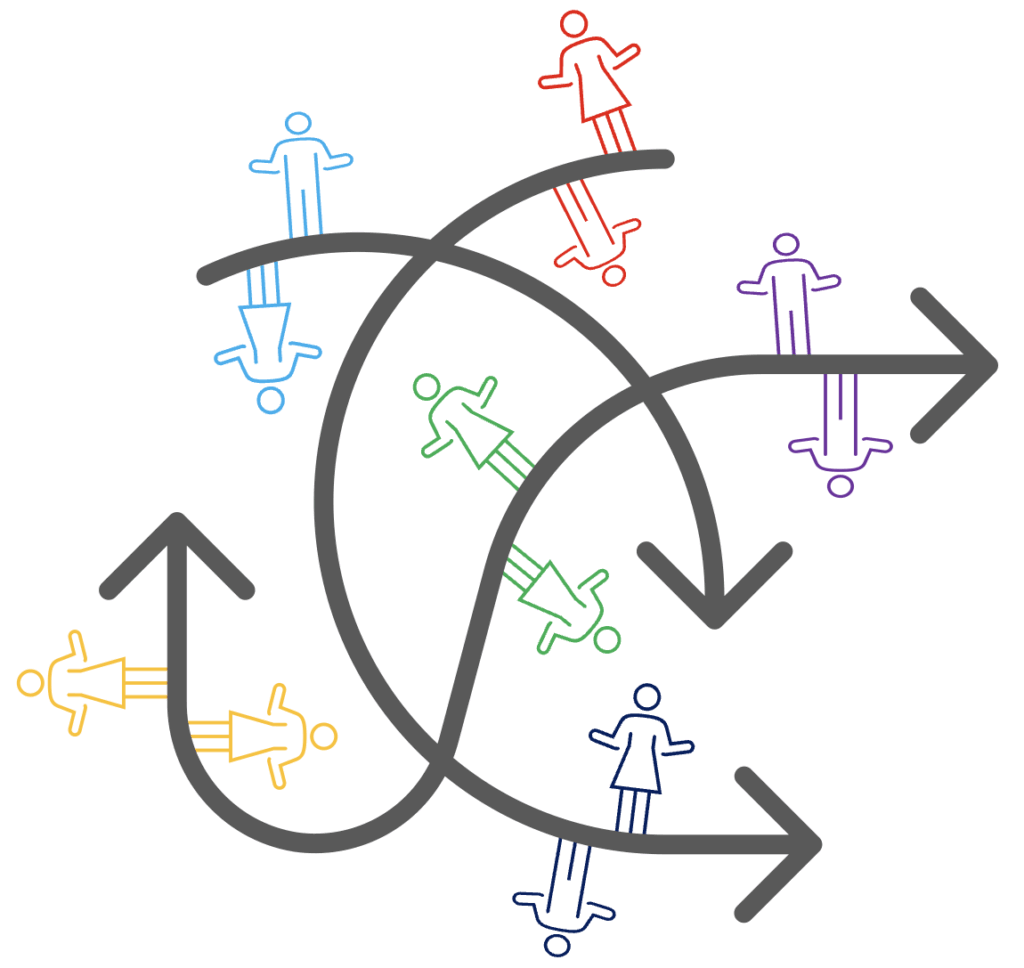
Sprechkompetenzen prüfen – aber wie?
Lehrpersonen beurteilen im Unterricht regelmässig die Sprechkompetenz ihrer Schüler_innen. Doch wie läuft das genau ab – und wie erleben Lernende solche Prüfungen? Eine neue Studie der Universität Freiburg liefert spannende Einblicke in mündliche Prüfungen im Fach Deutsch als Fremdsprache an Sekundarschulen. Die Ergebnisse zeigen: Zwischen Anspruch und Realität gibt es teils grosse Unterschiede – mit Folgen für die Fairness und Wirksamkeit der Beurteilungen.
Das Wissenschaftliche Kompetenzzentrum für Mehrsprachigkeit der Universität hat echte Prüfungen auf Video aufgenommen – in Paar- und Einzelsettings – und anschliessend Lehrpersonen und Schüler_innen auch interviewt. Zudem nahmen 254 Jugendliche an einer schriftlichen Befragung teil. Ziel war es, die gängige Prüfungspraxis zu analysieren und die Perspektiven beider Seiten besser zu verstehen.
Grosse Unterschiede im Prüfungsstil
Die Auswertung zeigt: Gerade Paarprüfungen laufen sehr unterschiedlich ab. Manche Lehrpersonen helfen den Schüler_innen bei Problemen nicht, andere leiten stark und übernehmen viel Redeanteil – fast wie im Unterricht. Solche Unterschiede wirken sich auf die Interaktion und die Leistung der Lernenden und damit auch auf die Bewertung aus.
Bewertungsraster unbeliebt
Ein Ergebnis der Studie betrifft das vorgeschriebene Bewertungsraster im Kanton Freiburg : Es ist wenig konkret, und muss auf ganz verschiedene Prüfungssituationen angewendet werden. Einige Lehrpersonen fühlen sich dadurch in ihrem fachlichen Urteil eingeschränkt und bemängeln auch, zu wenig im Umgang mit dem Raster geschult worden zu sein.
Prüfungen können auch motivieren
Trotz der Stresssituation sehen viele Schüler_innen die mündlichen Prüfungen positiv. Laut Umfrage geben 57 Prozent an, dass sie ihre Sprachkompetenz dadurch verbessern konnten – besonders in Paarprüfungen, die als weniger belastend und hilfreicher erlebt werden. Gleichzeitig gibt es Unsicherheiten beim Thema Feedback: Eine Mehrheit der Lehrpersonen bezweifelt, dass ihr Feedback von den Schüler_innen aufgenommen wird, gibt den Schüler_innen nach einer Prüfung aber auch kaum individuelle Ratschläge zur Verbesserung.
Was sich ändern muss
Die Studie macht deutlich: Für faire und sinnvolle Beurteilungen braucht es klare Ziele, passende Aufgaben und ein darauf abgestimmtes Beurteilungsinstrument. Um die Praxis zu verbessern, stellt das Projekt aufbereitete Videobeispiele echter Prüfungen zur Verfügung – als Unterstützung für die Aus- und Weiterbildung von Lehrpersonen.
Kontakt
Prof. Dr. Thomas Studer
Institut für Mehrsprachigkeit
thomas.studer@unifr.ch
+41 26 300 79 61
Quelle
Unicom Kommunikation & Medien
Avenue de l’Europe 20
CH-1700 Fribourg
+41 26 300 70 34
communication@unifr.ch
www.unifr.ch/unicom/de

Mieux apprendre les sons et le sens : la phonologie au service du vocabulaire
Est-il possible de mieux apprendre une langue étrangère en faisant plus attention aux manières de prononcer certains mots ? Il semblerait que l’intégration de la phonologie dans la didactique des langues étrangères offre des perspectives positives en ce sens. En témoigne la thèse de Nathalie Dherbey Chapuis (UniFR) qui propose des pistes didactiques concrètes pour aider les apprenant·e·s à faire des liens entre les sons et le sens.
Retrouvez l'entretien complet sur le site du CeDiLE et davantage d'informations sur le projet ici
L’enseignement bilingue dans tous ses états…et sous toutes ses formes!
On entend souvent dire que « l’immersion, c’est par exemple enseigner la géographie ou l’histoire dans une autre langue. » Si le principe semble simple, des chercheurs du laboratoire GRIDALP (Uni de Genève) ont récemment démontré que cet enseignement peut se manifester sous des formes très différentes, privilégiant parfois l’imposition d’un enseignement à caractère…monolingue. Éclairage avec Gabriela Steffen (collaboratrice scientifique @Uni Genève) qui présente également des séquences didactiques issues de leur projet réalisé dans le cadre du Centre scientifique de compétence sur le plurilinguisme.
Retrouvez l'entretien complet sur le site du CeDiLE et davantage d'informations sur le projet ici.
Individual differences in early instructed language learning: The role of language aptitude, cognition, and motivation
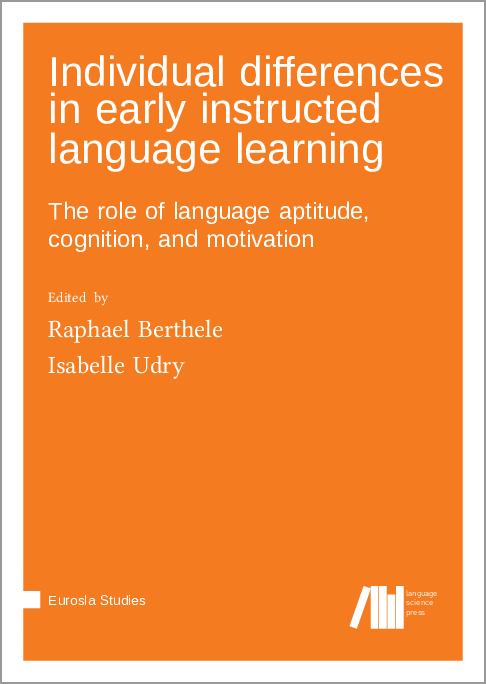
Variability in predispositions for language learning has attracted scholarly curiosity for over 100 years. Despite major changes in theoretical explanations and foreign/second language teaching paradigms, some patterns of associations between predispositions and learning outcomes seem timelessly robust. This book discusses evidence from a research project investigating individual differences in a wide variety of domains, ranging from language aptitude over general cognitive abilities to motivational and other affective and social constructs. The focus lies on young learners aged 10 to 12, a less frequently investigated age in aptitude research. The data stem from two samples of multilingual learners in German-speaking Switzerland. The target languages are French and English.
The chapters of the book offer two complementary perspectives on the topic: On the one hand, cross-sectional investigations of the underlying structure of these individual differences and their association with the target languages are discussed. Drawing on factor analytical and multivariable analyses, the different components are scrutinized with respect to their mutual dependence and their relative impact on target language skills. The analyses also take into account contextual factors such as the learners’ family background and differences across the two contexts investigated. On the other hand, the potential to predict learner’s skills in the target language over time based on the many different indicators is investigated using machine learning algorithms. The results provide new insights into the stability of the individual dispositions, on the impact of contextual variables, and on empirically robust dimensions within the array of variables tested.
Eurosla 31 - The 31st Conference of the European Second Language Association
EuroSLA 31, a yearly conference dedicated to all areas and approaches to the study of second, foreign, or additional languages, will take place in Fribourg/Freiburg (Switzerland) from 24 to 27 August, 2022. The academic program will include presentations by the participants as well as four invited keynote speakers:
- Sible Andringa, University of Amsterdam
- Aline Godfroid, Michigan State University
- Elke Peters, KU Leuven
- Rachel Shively, Illinois State University
We welcome submissions in all areas and approaches to the study of second, foreign, or additional languages. For more information, see the Call for papers or website
Next important dates:
- Abstract submission opens: 15 November 2021
- Deadline for abstract submission: 31 January 2022
- Notification of acceptance: April 2022
- Start conference registration: May 2022
Babylonia 2/2021 - Kinder mit besonderen Bedürfnissen
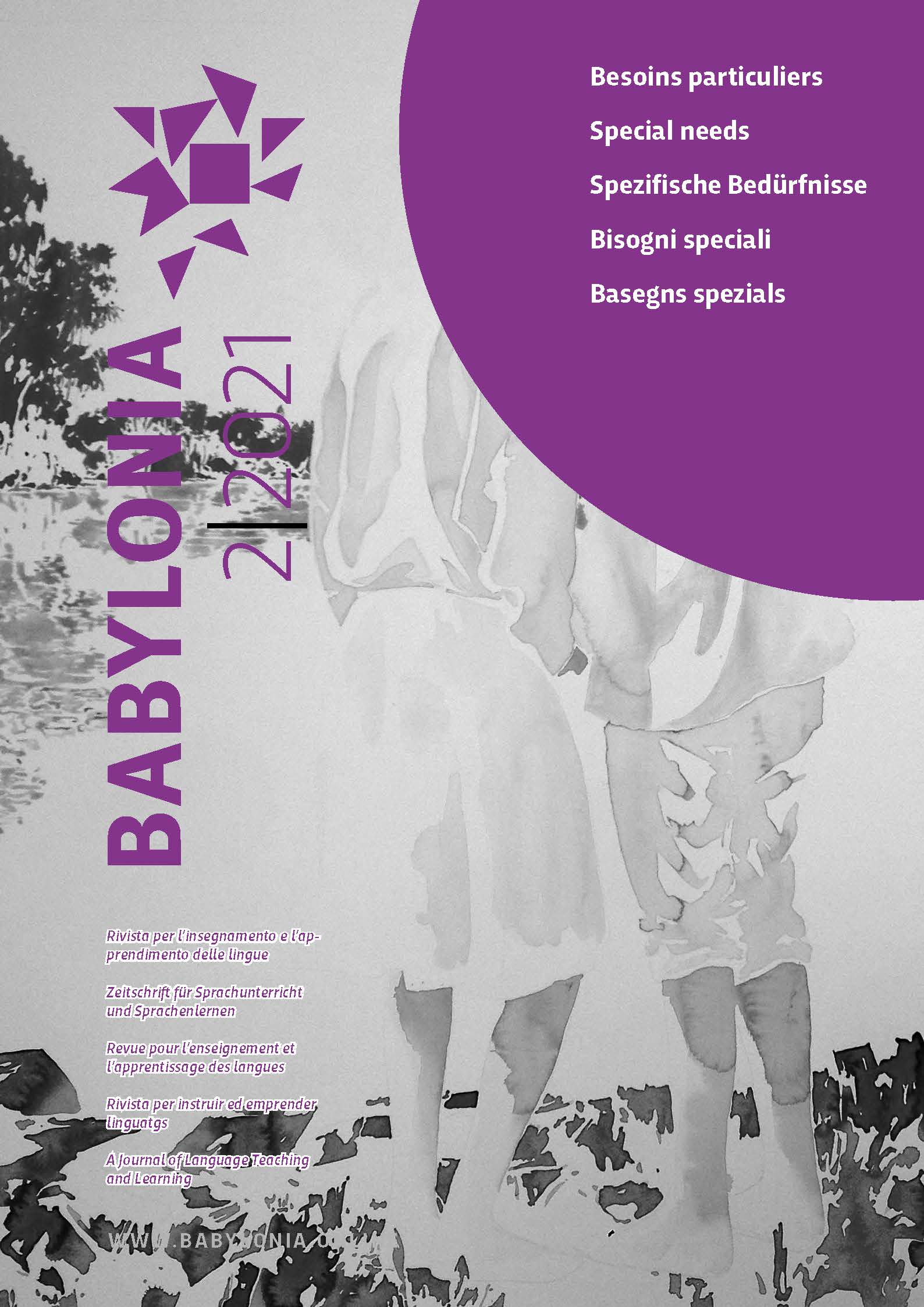 This issue of Babylonia presents an overview of special needs children’s profiles as well as the diversity of contexts in which these children evolve. The articles make it possible to grasp the complexity of different situations of vulnerability: on the one hand, the specificity of the children's profiles requires adapted care both in school and in logopedic care, and on the other hand, this constant adaptation to the child poses real challenges to schools and its various care services.
This issue of Babylonia presents an overview of special needs children’s profiles as well as the diversity of contexts in which these children evolve. The articles make it possible to grasp the complexity of different situations of vulnerability: on the one hand, the specificity of the children's profiles requires adapted care both in school and in logopedic care, and on the other hand, this constant adaptation to the child poses real challenges to schools and its various care services.
La revue est accessible en ligne ici : https://babylonia.online/index.php/babylonia/issue/view/14
Les langues en débat dans une Europe en projet
New publication by Zorana Sokolovska
Depuis quelques décennies, les discours de promotion et de valorisation du plurilinguisme imprègnent différentes sphères de la société. Divers
acteurs sociaux les façonnent et parmi ces derniers le Conseil de l’Europe occupe une place centrale dans la production et la circulation des
discours et des idées sur le plurilinguisme en Europe. Matérialisées dans différents instruments comme les recommandations, guides et cadres
de référence, ces idées construisent les bases d’un discours d’autorité.
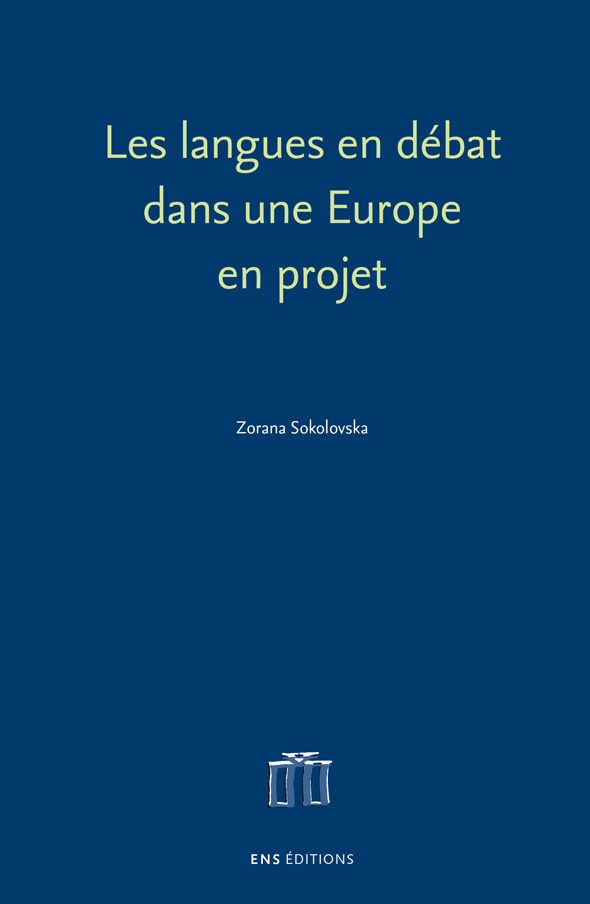
Au croisement de la sociolinguistique, l’analyse du discours et l’anthropologie institutionnelle, cet ouvrage étudie l’émergence et la circulation des idées sur les langues au sein du Conseil de l’Europe grâce à l’examen de textes institutionnels produits entre 1949 et 2008. Il s’interroge notamment sur ce qu’est le plurilinguisme, sur son rôle et ses enjeux pour la gestion de l’Europe.
Il propose par ailleurs une réflexion critique sur la mobilisation et la promotion d’une certaine vision des langues et du plurilinguisme afin d’exercer un pouvoir sur la scène internationale.
Cet ouvrage s’adresse aux sociolinguistes, analystes du discours, anthropologues et intéressera également les étudiants et professionnels du domaine politico-éducatif.
http://catalogue-editions.ens-lyon.fr/fr/livre/?GCOI=29021100186470
What is Special About Multilingualism?
New publication by R. Berthele & J. Vanhove (eds.), Currents in Language Learning Supplement
What is Special About Multilingualism?
https://onlinelibrary.wiley.com/toc/14679922/2021/71/S1
Four of the articles are Open Access.
- Berthele, R. (2021). Introduction: What is special about multilingualism? Language Learning, 71(S1), 5-11. https://doi.org/10.1111/lang.12436
- Critten, R. G., & Dutton, E. (2021). Medieval English multilingualisms. Language Learning, 71(S1), 12-38. https://doi.org/10.1111/lang.12404
- Beisbart, C. (2021). Complexity in multilingualism (research). Language Learning, 71(S1), 39-79. https://doi.org/10.1111/lang.12426
- Berthele, R. (2021). The extraordinary ordinary: Re-engineering multilingualism as a natural category. Language Learning, 71(S1), 80-120. https://doi.org/10.1111/lang.12407
- Festman, J. (2021). Learning and processing multiple languages: The more the easier? Language Learning, 71(S1), 121-162. https://doi.org/10.1111/lang.12437
- Lago, S., Mosca, M., & Stutter Garcia, A. (2021). The role of crosslinguistic influence in multilingual processing: Lexicon versus syntax. Language Learning, 71(S1), 163-192. https://doi.org/10.1111/lang.12412
- Frank, S. L. (2021). Toward computational models of multilingual sentence processing. Language Learning, 71(S1), 193-218. https://doi.org/10.1111/lang.12406
- Chuang, Y.-Y., Bell, M., Banke, I., & Baayen, R. H. (2021). Bilingual and multilingual mental lexicon: A modeling study with Linear Discriminative Learning. Language Learning, 71(S1), 219-292. https://doi.org/10.1111/lang.12435
D'une pierre 4 coups ?!
Le projet « D’une pierre 4 coups », né en Suisse italienne et réalisé grâce aux compétences de partenaires de toute la Suisse, propose des points de rencontre linguistiques et culturels entre les différentes régions linguistiques de notre pays. Ce projet comporte non seulement un livre, qui compare des expressions idiomatiques dans les quatre langues nationales, mais également des fiches didactiques pour les écoles (matériel pilote pour l’enseignement de l’italien) et des contenus interactifs pour le grand public.
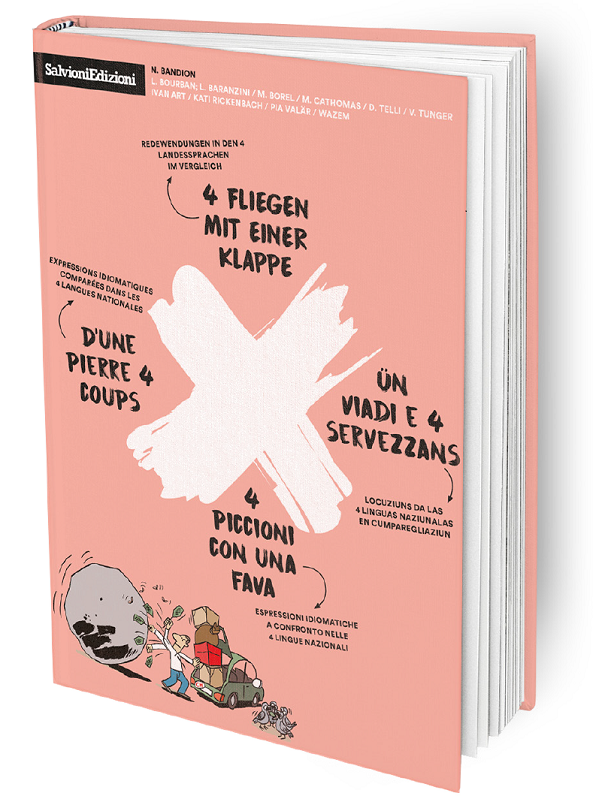
Figures of interpretation
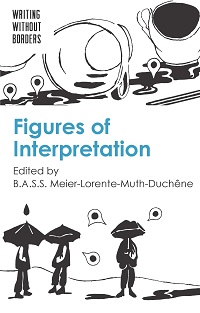
Figures of interpretation is a collective book which assembles 31 portraits of people who interpret languages, cultures and situations, and offers graphic interpretations of their collective experience. Their individual stories are part of the larger history of interpreters, interpretation and interpretive readings, and they demonstrate how language intersects with race, class, gender and geopolitical inequalities.
The book allows the unexpected to unfold by passing control from the writers to the reader, who will see connections and ruptures unfold between space, time and class while never losing sight of the materiality of living. Together and individually, the portraits tell a powerful story about the structure of contemporary society and the hierarchical distributions of power that permeate our lives."
The publisher is offering a 50% discount until the end of February. Please feel free to use the code mentioned in the flyer.
